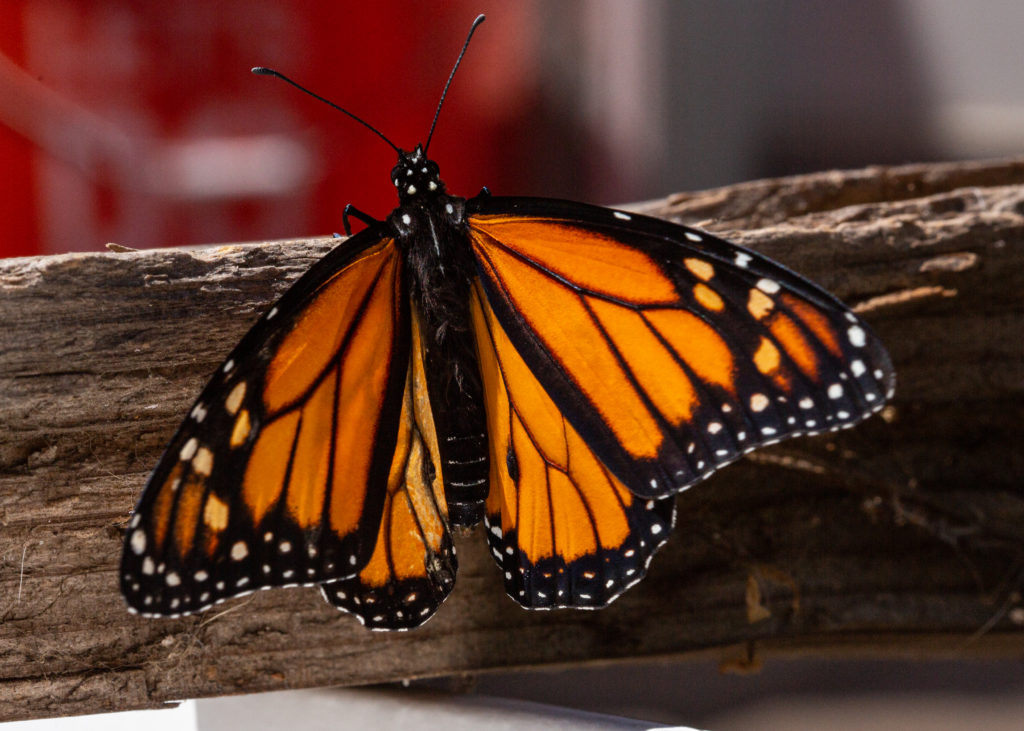
This has been the month of butterflies. We had a stand of milkweed in the front yard, Asclepias curassavica, or what I’ve heard called tropical milkweed. According to this source, it’s native to many islands across the Caribbean and parts of South America and introduced here in California. Monarch butterflies are partial to this plant, as well as other varieties of milkweed. This particular species is believed to pose a problem for the butterflies, though. It doesn’t get cold enough here in the winter to kill the plant. So the leaves and anything living on them survive from one butterfly season to the next.
One of the things that might live on the leaves is a parasitic protozoan called Ophryocystic elektroskirrha. Called OE in the world of monarch studies, the parasite can be debilitating, causing deformed wings in some monarchs and weakening others. The biological consensus seems to be that OE is everywhere. Adult monarchs carry it and deposit it on plants where they feed or lay their eggs. Eggs can be infected. More commonly, monarch caterpillars become infected when they eat infected vegetation, and infected caterpillars metamorphose in their chrysalides to infected adults that continue the cycle.
We didn’t know from OE when I picked up those plants a couple years ago. And we didn’t know about it when I grew a bunch of new plants from seed last year and planted them in the front yard. (We also didn’t know about a lot of the other surprisingly commonplace organisms that can come along and kill monarchs, either, but that’s another story.) By last fall, we had read about OE. But we left the tropical milkweed standing because, well, it was there and no monarchs were around.
But late in the winter, there was some monarch mating activity we didn’t witness. By late March, monarch caterpillars had appeared in the milkweed. I only saw a few at first, but over the coming weeks, we counted about 40 of them in our small milkweed patch, all seemingly at a similar stage of development. They systematically devoured the leaves on one plant after another until they had stripped all the milkweed bare.

Then the caterpillars migrated to various spots around the front entrance of the house. Kate counted 30 chrysalides by the time the great pupation was finished. The stumpy remains of a pomegranate bush was the most popular chrysalis site. But we also found them on our mailbox, on one of the pillars of our front porch, on the porch stairs, on a stalk of fennel, on random pieces of wood, and next door on a neighbor’s bicycle lock cable, dog leash, fence and gate.

A couple weeks ago, they started emerging. Twenty-five so far, we think. (Kate, the science teacher, has mapped and charted the location of each. She’s also interested all the neighborhood kids in what’s going on, so we sometimes have a sort of free-form, socially distanced classroom in the front yard.)
Since we knew about OE and its effects, we were a little concerned about the condition of the butterflies that would emerge from all the chrysalides. All but about five have appeared to be healthy, emerging with no problems, all parts intact, and flying off very quickly after their wings dried.

What about the rest, the ones that have not appeared healthy or died before they emerged? Well, there’s another story there. Complete with actual butterfly names. To be continued.
***
A couple of days ago, the phrase Rancho Mariposa came into my head while I was describing the parade of monarch’s appearing on the estate here.
“Mariposa” is Spanish for “butterfly,” and it’s a street name here in Berkeley and over in San Francisco and I’m betting in many, many other towns. The name has been stuck on a Sierra foothills county, on that county’s biggest town, and on a creek that runs through both. “Mariposa” was apparently first used as a California place name there.
It’s easy enough to imagine how the name came to be. Someone saw a bunch of butterflies somewhere and was inspired to name the place for the insects. You hope for a more particular story, and there is one in which butterflies aren’t lovely, fragile ephemera but a memorable nuisance.
An 1806 Spanish expedition struggling through an unattractive stretch on the eastern edge of the San Joaquin Valley encountered an unattractive-looking stream. A priest with the party, Pedro Muñoz, recorded what they found there.
September 27: In the morning we crossed the river and, taking a northerly direction, we pushed through about a league of very high, thick tules, in the midst of which could be seen a few clearings well covered with grass. After traveling about three leagues, more or less, we stopped at a stream which runs from east to west. It has no running water, only a few pools, where we were forced to pitch camp. From the point where we left the tule swamps to this place the land is really miserable. Salt flats and alkali patches, with innumerable ground-squirrel burrows are all that one can see. There are at this spot about sixty oak trees and a few willows in the bed of the stream. The forage was extremely scanty, and that the country appeared to have been burned over by the Indians did not conceal the fact that the land is very poor. Consequently there is little pasturage.
This place is called the Mariposas, “the butterflies,” because of their great number, especially at night. In the morning they become extremely troublesome, for their aggressiveness reaches the point where they obscure the light of the sun. They came at us so hard that one of them flew into the ear of a corporal of the expedition. It caused him much discomfort and no little effort to get it out.
